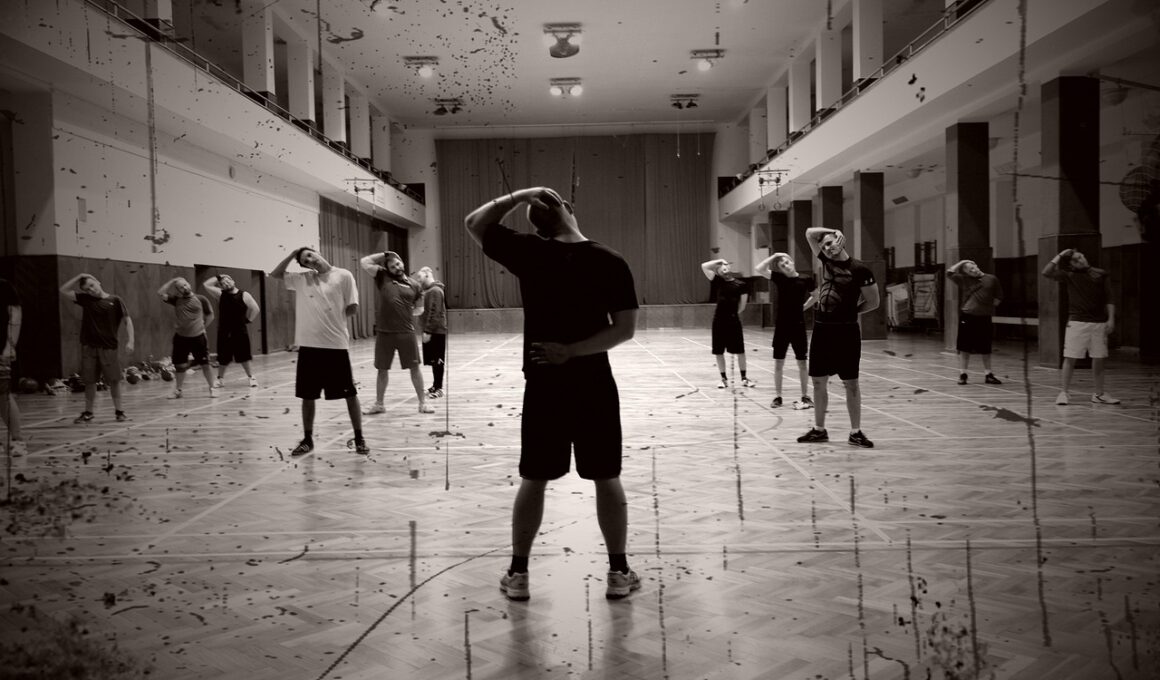Freerunning Warm-Up Routines to Avoid Injuries
Freerunning, while exhilarating, poses several risks if adequate warm-up routines are not followed. Understanding the importance of a warm-up is crucial for any athlete, especially those engaged in intense physical activities like freerunning. A good warm-up routine not only prepares both the mind and body for the upcoming physical challenges but also significantly reduces the risk of injuries. An effective warm-up typically involves dynamic stretches, which serve to enhance mobility and blood flow. Before jumping into intricate maneuvers, performing specific exercises tailored for freerunners can be beneficial. A systematic approach allows individuals to gradually increase their heart rates and muscle temperatures. This preparation aids in improving overall performance and efficiency during practice or competition. Additionally, including a mix of strength and flexibility exercises throughout your warm-up can further enhance physical readiness. Tailoring warm-up routines to target commonly used muscle groups in freerunning helps ensure that the body is primed for more complex movements. Start by engaging in movements that replicate the actions involved in freerunning, such as lunges or leg swings, and follow up with agility drills to sharpen reflexes and coordination.
Implementing proper warm-up techniques significantly impacts injury prevention. A well-structured warm-up allows athletes to be mentally prepared, focusing on the upcoming moves they plan to execute. Moreover, consistency in following warm-up routines can lead to improved overall performance in various freerunning activities. Athletes should aim to include a balance of cardiovascular activities followed by dynamic stretching. Some effective exercises include high knees, butt kicks, and arm circles to loosen up the body. It’s essential to keep moving during the warm-up to prevent muscles from cooling down, which can increase the risk of strains or sprains during more intense activities later. Also, it is useful to maintain an increased heart rate by integrating short bursts of activity, allowing for better oxygen delivery to your muscles. Furthermore, practicing basic freerunning movements in slow motion can help refine technique while ensuring muscles are prepared for rapid movements. High-impact exercises should be introduced only after the muscles are sufficiently warmed up. Finally, ensure to listen to your body, as it may provide cues indicating that certain areas need extra attention during your routine.
Key Elements of a Freerunning Warm-Up
In incorporating a warm-up routine, it is vital to focus on specific areas of the body that are heavily engaged in freerunning. Some essential components to consider include joint mobility, muscle dynamics, and balance. For joint mobility, performing gentle rotations and stretches can help enhance flexibility, preventing potential injuries during high-impact movements. Pay attention to wrists, ankles, and hips; they tend to bear the brunt of various techniques in freerunning. Muscle dynamics involve movements that lengthen and strengthen muscles simultaneously. Bodyweight exercises like squats or lunges, combined with stretches, can effectively target muscle groups crucial to freerunning proficiency. Balance training is also essential; including exercises like single-leg stands and dynamic balance movements can improve stability. Stability aids in safe landings, which minimizes the risk of falls or twisted ankles. Moreover, embracing different techniques ensures that no single routine becomes monotonous or ineffective. Additionally, varying the warm-up over time can keep it engaging. The goal should be to create a fun and motivational atmosphere for warm-ups, as such an approach can enhance commitment and overall performance.
After focusing on key areas, monitoring the duration of warm-up sessions is equally vital. Typically, a comprehensive warm-up should last between 15 to 30 minutes—offering sufficient time for muscle activation and cardiovascular preparation. However, this can vary depending on individual fitness levels and specific needs. Beginners may require a longer period to warm up compared to seasoned athletes. It’s crucial to strike a balance that maximizes effectiveness without over-exertion. Furthermore, as weather conditions can also impact body temperatures, adjustments may be necessary to ensure adequate conditioning. For instance, cold environments may require longer warm-ups to ensure that muscles reach optimal temperatures, while warmer climates might allow for shorter routines. Staying hydrated throughout the warm-up can also facilitate muscle performance, making movements smoother and more efficient. To further enhance focus during these warm-ups, consider incorporating music or a warm-up partner, fostering a sense of community while working on essential skills. Ultimately, the right balance of physical activity during a warm-up can set an athlete up for a successful freerunning session, ensuring longevity and excitement in the sport.
Dynamic Stretching Techniques
Dynamic stretching techniques serve as an excellent precursor to any rigorous physical activity, including freerunning. This method involves continuous movement and muscle engagement, significantly enhancing flexibility and strength. Unlike static stretching, where muscles are held in a position for a duration, dynamic stretching seamlessly transitions from one movement to another. Specific exercises such as leg swings, arm circles, and torso twists can warm up muscle groups effectively. By integrating these stretches into the warm-up routine, athletes can prepare their muscles for the dynamic forces experienced during freerunning. Furthermore, focusing on the core, legs, and upper body provides a comprehensive workout. This preparedness is essential in executing powerful jumps, flips, and other intricate tricks. Additionally, engaging in sport-specific drills, such as practicing landing techniques or vaults, ensures that muscles become accustomed to similar patterns experienced during actual runs. Transitioning smoothly between various dynamic stretches keeps the heart rate elevated, priming the body for high-energy movements. Incorporating these elements ensures that no muscle group is neglected, maintaining balance and function throughout the warm-up, leading to safer freerunning experiences.
Another significant aspect of warm-ups involves integrating agility and coordination drills. These drills not only bolster speed and reaction time but also enhance overall athletic performance. During warm-up sessions, dedicating a few minutes to agility-enhancing exercises can yield remarkable benefits. For instance, implementing ladder drills, cone sprints, or shuttle runs can effectively train the body for rapid directional changes that characterize freerunning. These movements often resemble the specific routines undertaken in actual freerunning practice. Agility training can significantly improve balance and confidence, reducing the chances of falling when performing challenging maneuvers. Moreover, these exercises prepare the nervous system for the upcoming demands, ensuring better communication between the brain and muscles, leading to refined movements. Additionally, breathing techniques during these drills should not be overlooked; learning to breathe rhythmically aids in maintaining stamina throughout sessions. Finally, ensuring that all aspects of warm-up routines are performed with purpose and intensity can improve the overall effectiveness. By investing time in agility and coordination drills, freerunners can significantly boost their performance while minimizing injury risk during extensive training.
Conclusion
In conclusion, incorporating effective warm-up routines is essential for anyone engaged in freerunning. Given the physical demands of this sport, it’s crucial to prioritize preventing injuries through systematic preparation. The correct routine should encompass various components, including dynamic stretching, cardiovascular activities, and sport-specific drills. Engaging different muscle groups helps prepare the entire body for high-intensity movements, fostering flexibility, and strengthening. Additionally, improving balance through targeted exercises creates a strong foundation essential for safely executing tricks and landings. It is equally important to adjust warm-up durations and routines based on personal needs, environmental conditions, and specific sessions. Utilizing agility and coordination drills enhances readiness for complex maneuvers, ultimately showcasing the athlete’s capabilities. Regularly integrating these elements promotes consistency, engagement, and safety. As freerunning continues to evolve, embracing a holistic approach to warm-ups will support athletes in reaching their full potential while laying the groundwork for a fulfilling journey in this exciting sport. Prioritize the efforts to warm up effectively, as this investment will yield long-term benefits for both performance and overall well-being.


